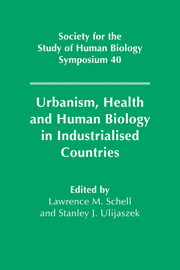Book contents
- Frontmatter
- Contents
- List of contributors
- Part I The urban environment
- 1 Urbanism, urbanisation, health and human biology: an introduction
- 2 Urbanisation and urbanism in industrialised nations, 1850–present: implications for health
- 3 Urban development and change: present patterns and future prospects
- 4 Transitional environments: health and the perception of permanence in urban micro-environments
- Part II Epidemiology
- Part III Poverty and health
- Part IV Behavior and stress
- Part V The future
- Index
3 - Urban development and change: present patterns and future prospects
Published online by Cambridge University Press: 06 January 2010
- Frontmatter
- Contents
- List of contributors
- Part I The urban environment
- 1 Urbanism, urbanisation, health and human biology: an introduction
- 2 Urbanisation and urbanism in industrialised nations, 1850–present: implications for health
- 3 Urban development and change: present patterns and future prospects
- 4 Transitional environments: health and the perception of permanence in urban micro-environments
- Part II Epidemiology
- Part III Poverty and health
- Part IV Behavior and stress
- Part V The future
- Index
Summary
Editors' introduction
There is extensive and remarkable diversity in urban forms and distributions around the globe; explaining rather than describing the diversity is difficult. Variations in urban forms do not correspond very closely to the economic development of the nations in which cities are located. Such terms as “developed” and “developing” are classificatory devices only, and do not explain variation in the distribution of urbanism any more than the antiquated classificatory terms Caucasoid or Negroid really explain variation in human biological characteristics. Variation in urban distributions is the result of history, culture and resources. Today, tremendous variation exists among nations in the growth of urban populations, the proportion of urban residents and the spread of urban lifestyles. With so much variety in urban change, it is exceedingly difficult to imagine a specific referent to the single category of urban. Thus, urban–rural comparisons are artificial contrasts that ignore the variation in urban places and distribution that Clark so ably describes. Future changes in urban population growth, urbanisation and urbanism will produce cities that are quite different from ones today, but, indisputably, the future is of Homo sapiens is an urban one.
One hundred years ago, in 1899, Adna Ferrin Weber published a thesis on The Growth of Cities in the Nineteenth Century.
- Type
- Chapter
- Information
- Publisher: Cambridge University PressPrint publication year: 1999



